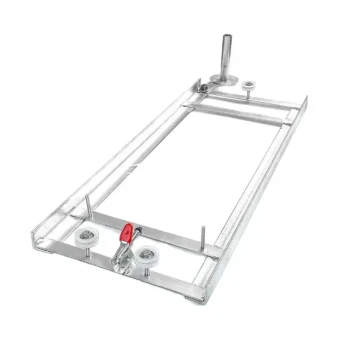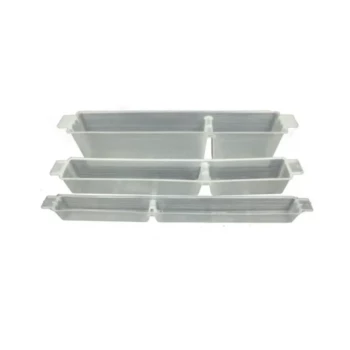In practice, beekeepers do not feed bees through a Cypress Screened Bottom Board, but rather use it as a strategic base for certain types of feeders. The board's primary function is hive ventilation and pest management, but its design makes it an ideal location for an entrance feeder or for containing spills from an internal feeder placed above it, keeping the colony clean and safe.
The screened bottom board is not a feeder itself, but a foundational tool for hive management. When feeding, its key role is to provide a stable, external platform that minimizes pests and keeps the hive hygienic by allowing spills and debris to fall away from the colony.

The Role of the Screened Bottom Board in Feeding
A screened bottom board provides a "false floor" for the hive. The fine mesh screen allows air, debris, and Varroa mites to pass through, but prevents bees from exiting or intruders from entering through the bottom.
A Platform for External Feeders
The most common method is placing an entrance feeder at the hive's opening. This type of feeder rests directly on the landing area of the bottom board, allowing bees to access sugar syrup without the beekeeper needing to open the hive.
Containing Spills and Preventing Robbing
Whether you use an entrance feeder or an internal feeder, spills can occur. A screened bottom board allows excess syrup to drip through and out of the hive, rather than pooling on a solid floor. This prevents a sticky mess that can attract ants, wasps, and robbing bees from other colonies.
Promoting Overall Hive Hygiene
The board's primary benefit is ventilation and sanitation. By allowing debris to fall out, it reduces the workload for house bees and lowers the population of pests like Varroa mites. A healthier, less-stressed hive is better able to manage its own resources, reducing the need for supplemental feeding.
Understanding When and Why to Feed
Feeding is a strategic intervention, not a routine task. Responsible beekeepers feed only when necessary to ensure the colony's survival and strength, never for the purpose of honey production.
For Newly Installed Colonies
A new package of bees has no drawn comb, no honey stores, and no pollen reserves. Feeding a 1:1 sugar-to-water syrup provides the critical energy worker bees need to build wax comb, allowing the queen to begin laying eggs and establish the brood nest.
During a Nectar Dearth
Sometimes, environmental conditions like drought or a late frost can create a "dearth," a period when few nectar-producing plants are in bloom. Feeding during these times can prevent a colony from starving.
To Stimulate Brood Rearing
In late winter or early spring, a light feeding can simulate an early nectar flow. This encourages the queen to ramp up egg-laying, ensuring a large workforce is ready for the main honey flow when it arrives.
Understanding the Trade-offs of Feeding
While necessary at times, feeding bees with sugar syrup comes with significant considerations that every beekeeper must weigh.
The Risk of Honey Adulteration
This is the most critical rule of feeding. Never feed sugar syrup while you have honey supers on the hive. Bees will store the syrup just like nectar, and it will adulterate your honey, compromising its integrity and flavor. Feeding is for the bees' health, not for your harvest.
Encouraging Robbing Behavior
While a screened board helps, the presence of feeders can still incite robbing from stronger, nearby hives. Always use entrance reducers to make the hive easier to defend and consider using slow feeders that minimize exposure.
Creating Hive Dependency
Over-reliance on feeding can mask underlying issues with a colony or its environment. The ultimate goal is a self-sufficient colony that can thrive on the natural forage available in your specific area.
Making the Right Choice for Your Goal
Your reason for feeding dictates the method you should use. Always prioritize the long-term health and natural behavior of your bees.
- If your primary focus is establishing a new colony: Feed a 1:1 sugar syrup using an entrance feeder to provide quick energy for comb building.
- If your primary focus is preventing starvation: Feed a 2:1 sugar-to-water syrup in the fall to help bees build up dense winter stores, or a 1:1 syrup during a summer dearth.
- If your primary focus is producing pure, natural honey: Stop all feeding well before the main nectar flow begins and before you add your honey supers.
Ultimately, view feeding as a powerful but temporary tool to support your bees when they need it most.
Summary Table:
| Feeding Purpose | Best Practice | Screened Bottom Board Benefit |
|---|---|---|
| New Colony Setup | Use 1:1 sugar syrup with entrance feeder | Provides stable platform, prevents spill accumulation |
| Nectar Dearth | Supplemental feeding during scarcity | Allows syrup drips to fall through, reducing pest attraction |
| Brood Stimulation | Light feeding in late winter/spring | Maintains ventilation while supporting colony health |
| Winter Preparation | 2:1 sugar syrup for winter stores | Keeps hive dry and clean during heavy feeding periods |
Upgrade Your Beekeeping Operations with HONESTBEE
As commercial apiaries and equipment distributors know, proper hive management tools are essential for successful beekeeping operations. Our Cypress Screened Bottom Boards are specifically designed to support strategic feeding practices while maintaining optimal hive hygiene.
We supply durable, wholesale-priced beekeeping equipment that helps professional beekeepers:
- Reduce pest problems through improved ventilation
- Maintain cleaner hives during feeding operations
- Support colony health with proper equipment design
Ready to enhance your hive management system? Contact our wholesale team today to discuss bulk pricing and equipment solutions tailored for commercial beekeeping operations.
Visual Guide

Related Products
- Langstroth Screen Bottom Board for Beekeeping Wholesale
- Australian Pine Wood Langstroth Screen Bottom Board for Wholesale
- Langstroth Solid Bottom Board for Beekeeping
- Professional Insulated Winter Hive Wrap for Beekeeping
- Boardman Entrance Bee Feeder Durable Galvanized Steel and Wood Construction for Beekeeping
People Also Ask
- What are the benefits of a screened bottom board? Boost Hive Health & Control Varroa Mites
- What are the benefits of using a screened bottom board in warm or humid climates? Boost Hive Health & Control Pests
- How does a screened bottom board assist with temperature control and pest management? A Key Tool for Modern Beekeeping
- What are the advantages of a screened bottom board? Boost Hive Health with Superior Ventilation & Pest Control
- What are the assembly options for the Cypress Screened Bottom Board? Ready-to-Use for Immediate Hive Health



















